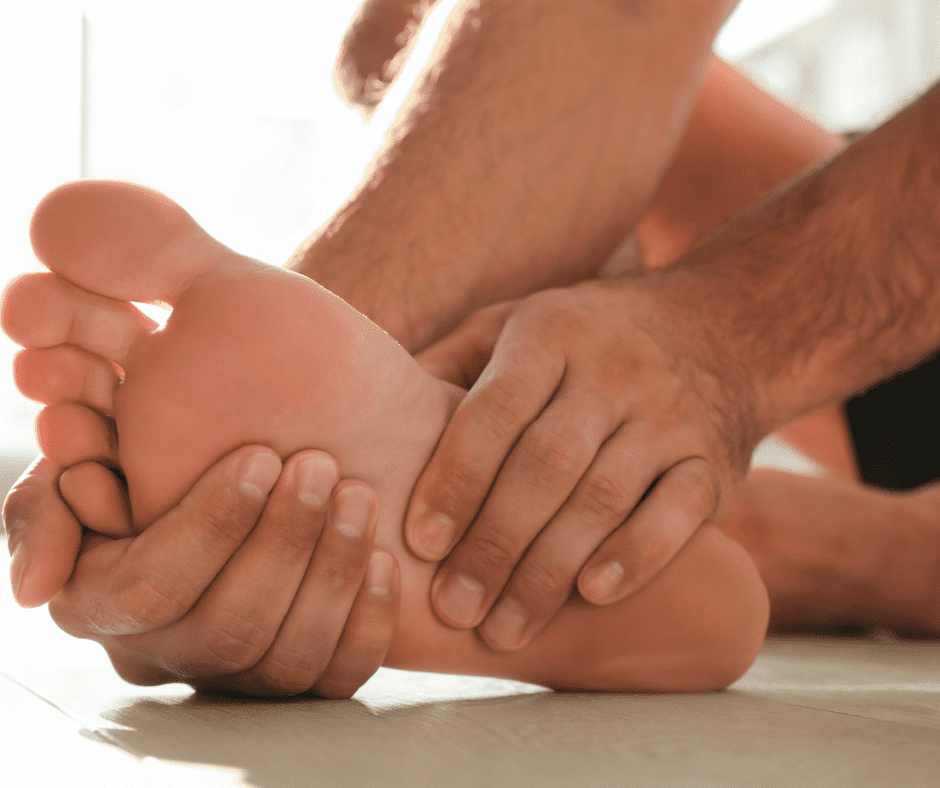Diabetes is a chronic, lifelong condition that can become life-threatening if not treated effectively.
Foot pain can be a symptom of diabetes, but it is not always the case. Because diabetes causes an increase in your blood sugar or glucose levels, this high volume of glucose can lead to nerve damage and problems with blood circulation. This can result in foot pain or numbness. In some cases, people with diabetes may also experience foot ulcers or infections that cause pain. However, foot pain can have many other causes, including injury, arthritis, or plantar fasciitis.
With diabetes, you may not be able to feel pain or sensitivity if you have a cut, blister or burn and are likely to suffer from poor circulation, particularly in your feet and legs, which means any wounds can take a lot longer to heal. Infections that don’t heal due to poor blood flow can lead you to be at a higher risk for developing ulcers or gangrene (the death of tissue due to a lack of blood). Minor scrapes, cuts that heal slowly, or the rubbing of shoes that do not fit well can all cause foot ulcers.
For all these reasons, if you have diabetes, any foot problems can become severe as they can develop very quickly if left untreated. According to Diabetes UK, data shows that 169 amputations are carried out a week. That’s 24 amputations a day and 1 amputation every hour in the UK only.
When living with diabetes, early prevention is the most effective way to manage and avoid any foot problems turning into serious complications. Prevention starts with a daily examination of your feet to spot any cuts, sores, blisters, corns, calluses, any signs of redness, swelling or any changes to the skin or nails at the earliest appearance.
In addition, as part of your diabetes care annual review, your feet should receive a thorough foot examination once a year. Getting your feet checked by your doctor or podiatrist annually is extremely important to establish if there are any conditions of concern and determine your risk for developing foot problems.
What should you expect during your foot examination?
Your diabetes annual foot exam is a preventive measure to enable you to take care of any foot problems before they become serious.
The test is typically arranged by your GP surgery, at your hospital appointment or performed in a specialist foot clinic like ours.
There are several exams that your health professional or podiatrist will need to carry out.
1. General health check First, there is a thorough examination of your feet and legs. This examination reviews their overall health and looks for any scrapes on the skin, checks the skin’s temperature to see if it’s warm or cool and if there are any patches of hair loss. Your toenails will also be inspected at this stage. It is advisable to remove any nail polish to enable the examiner to look for any nail fungus or discolouration of the nails that may indicate there is trauma or infection.
Both your legs and feet will be carefully examined from the top to the soles, heels and also in between the toes to see if there is any skin softening, lacerations, ulcers, corns or abrasions as they can quickly develop into a more severe condition. Thick calluses on the bottom of the feet can also be of concern as they can lead to ulcers.
Afterwards, your doctor or podiatrist will proceed to do a musculoskeletal examination, checking your bones and joints for disfiguration and problems such as hammertoes or claw toes, deformities of the foot and your ankle’s motion. They will also make sure you are able to bend and move your toes without difficulty.
2. Testing for nerve damage and feeling in your feet When the nerves in your feet are damaged because of the high levels of blood sugar and, consequently, poor circulation, your feet can lose the ability to feel. With the aid of a monofilament, a biothesiometer or a calibrated tuning fork, your examiner will touch your toes and feet in several places to test whether your nerves are detecting the feeling and check if you can feel any vibrations and detect the monofilament.
3. Testing for blood circulation During this process, the two pulses of your foot — one at the top called the Dorsalis Pedis and one behind the tibia called the Posterior Tibialis — will be assessed. Your examiner will also check the blood pressure in your legs.
Once the examination is completed, your doctor or podiatrist will share with you the results, highlighting any abnormalities and how much you’re at risk of developing foot problems. The level of risk ranges from: Low – no abnormalities or calluses that have no complications. Moderate – there is one foot problem, such as a loss of sensation or a change in foot shape. High – there are several foot problems, including poor circulation, loss of feeling in your feet, spreading infection and serious ulcers that can lead to amputation.
If your level of risk is moderate or high, you’d need to get treated immediately. Doing so reduces the chances of developing gangrene or ulcers from an infection, which can lead to an amputation of your toe, foot, or part of your leg.
It is important to consult a podiatrist if you are experiencing persistent foot pain or other symptoms, especially if you have risk factors for diabetes such as a family history, obesity, or high blood sugar levels.
For more information about getting your foot examined if you have diabetes, book an initial consultation.








